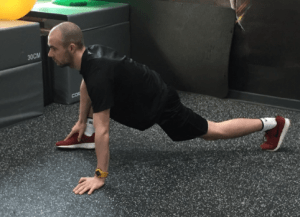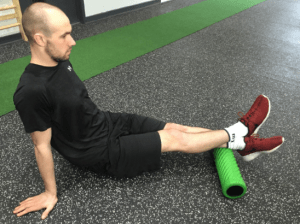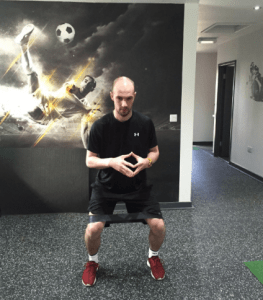Drill 1: Squatting This is a fundamental movement skill. As children and babies we all squat, crawl and lunge but due to the demands of work and injuries through life, we lose the ability and mobility to execute these drills correctly, writes Tom Heeley.
The stretches and drills I will examine in this set of blogs will help to improve the mobility in your hips, the ability to dissociate between lumbar and pelvis and functionality of using those muscles we have forgotten how to.
‘SPIDERMAN’
This is a great squat mobility drill to improve adductor complex range of the lead leg, hamstring flexibilty of the lead leg, hip flexor range of the trail leg and also the functionality of being able to balance on one leg.
This drill can be advanced further by using the elbow to drive the lead knee out.
You can also add in thoracic rotation if the base of support is sturdy enough.
This drill can be alternated between legs as a much more dynamic free flowing drill or could be advanced into a bear crawl type drill on a track and move forwards and backwards.
Drill 2: Hip Hinging This may look strange but it is a great exercise to help reach our goal of better squats, writes Tom Heeley.
The ability to dissociate between the lumbar (lower part of the back) and the pelvis is vitally important for most fundamental tasks in life and inability to do this is often a cause of lower back pain. The amount of people who suffer from lower back pain on a regular basis is enormous.
In this hip hinging drill, hold a long thin stick like a broomstick or dowel along your spine, maintaining contact with your pelvis, mid thoracic (middle of your back) and base of your skull.
Tuck your buttocks underneath your hips, tighten your gluteals and abdominals and try to stack each vertebra on top of one another. Now, when you lean forwards, maintain those points of contact with the broom and lean as far as possible. You will start to feel a pull along your hamstrings.
This can be advanced to a single leg arabesque (single leg squat) exercise or an RDL (Romanian Dead Lift).
Drill 3: Self Gluteal Myofascial release: The gluteal muscles are a common area for tightness and reduced mobility for a lot of us, writes Tom Heeley.
They have a large pain referral pattern and trigger points here can spread far and wide throughout the body to cause more discomfort.
Using an Active Ball from Function Jigsaw’s Active Kit Range, place it under your right gluteal, place your right foot onto your left knee and pick your buttocks up using your arms and shoulders. Then, gently roll forwards, backwards and side to side, making sure to cover the whole gluteal area.
Drill 4: Calf Active Rolling: Your ankles’ range of movement plays a key role in the depth and quality of a squat and your calf plays a big part in that, writes Tom Heeley.
An attempted squat where you cannot achieve sufficient depth without having to raise up onto your toes is often because of a lack of both calf and ankle mobility.
One easy way to improve that mobility and flexibility is by using an Active Roller.
By placing the roller under your calf muscles, you can either place one foot on top of the other, or keep both feet on the roller.
Pick your bum up and gently roll forwards and backwards on the roller several times. One simple way to ensure you can target the whole calf is by turning your toes in and out for a number of attempts. This will affect the medial and lateral triceps surae group and make sure that the whole of the muscle is targeted.
Drill 5: Gluteal strengthening: Despite the gluteal muscles being an area for tightness and trigger points they are commonly an area of underdevelopment too, writes Tom Heeley.
The gluteal muscles are made up of the gluteus maximus, gluteus minimus and gluteus medius, collectively they provide extension of the hip, abduction and external rotation.
They reduce knee valgus – a commonly seen dysfunction in the lower limb, which coincidentally is also a common mechanism for injury in the lower limb.
The gluteal muscles help to provide a lot of force during a squat (a fundamental movement) and triple extension mechanics. Triple extension is the principle by which toes are pointed, knees extended and hips extended fully to provide a maximal force when running, jumping and bounding.
Drill 6: Kossak Squat: The Kossak squat is a great way to dynamically warm up each leg individually,
writes Tom Heeley.
When done to the shape of a box, it allows for comfortable and objectively measurable improvements.

Tom doing a Kossak squat.
It is also a perfect exercise for improving adductor range flexibility, medial hamstrings and control on one leg. They can be done by using your bodyweight or with a kettle bell in your hands held in front of you.
Kossack squats will help to reduce valgus knee positions (a commonly seen dysfunction in the lower limb) and are ideal for those who have been sitting at a desk for a prolonged period prior to training.
They can be challenged further by lowering the box, raising the trail leg off the floor or varying the exercise into a dynamic high knee routine. These can be completed as part of a sprinter’s or runner’s routine over and under hurdles through range measurable by the height of the hurdle.











